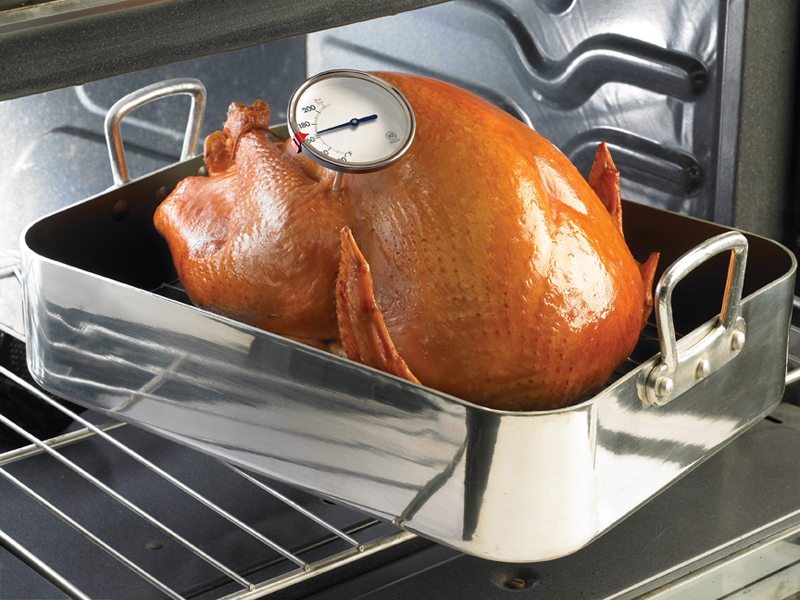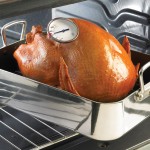
by Judy Corbus | Nov 27, 2015
 Have questions about safely preparing your holiday meal? Refer to this quick reference for answers to common questions this time of year:
Have questions about safely preparing your holiday meal? Refer to this quick reference for answers to common questions this time of year:
Q. Approximately how long should you allow for thawing a frozen turkey in the refrigerator?
A. 24 hours per each 4 – 5 pounds of turkey. In it’s original wrapper, place the frozen bird in the refrigerator (40˚F or below). To prevent cross contamination, be sure to place the turkey in a container. A thawed turkey can remain in the refrigerator for 1 – 2 days.
Q. How long should I cook the turkey?
A.
COOKING TIME – UNSTUFFED
Size of Turkey Estimated Time to Reach 165˚F
8 – 12 pounds 2 ¾ – 3 hours
12 – 14 pounds 3 – 3¾ hours
14 – 18 pounds 3 ¾ – 4 ¼ hours
18 – 20 pounds 4 ¼ – 4 ½ hours
20 – 24 pounds 4 ½ – 5 hours
COOKING TIME – STUFFED
Size of Turkey Estimated Time to Reach 165˚F
8 – 12 pounds 3 – 3 ½ hours
12 – 14 pounds 3 ½ – 4 hours
14 – 18 pounds 4 – 4 ¼ hours
18 – 20 pounds 4¼ – 4 ¾ hours
20 – 24 pounds 4 ¾ – 5 ¼ hours
Q. What is a safe internal temperature for cooking a whole turkey?
A. 165˚F. Use a food thermometer to check the internal temperature of the turkey. Insert the thermometer in the innermost part of the thigh and wing and the thickest part of the breast, making sure not to touch the bone. All turkey meat, including any that remains pink, is safe to eat as soon as all parts reach at least 165˚F. Let the turkey stand 20 minutes after removing from the oven. Remove any stuffing and carve the turkey.
Q. What is the recommended temperature for stuffing?
A. 165˚F. The stuffing should reach 165˚F whether cooked inside the bird or in a separate dish.
Q. I want to stuff the turkey. How do I do this safely?
A.
1. Cook any raw meat, poultry, or shellfish you plan to use before stuffing the turkey. Do not mix wet and dry ingredients until just before stuffing the turkey cavity; wet ingredients can be prepared ahead of time and refrigerated.
2. Spoon stuffing directly into the cavity right after preparation. Stuff loosely – plan for ¾ cup of stuffing per pound. The stuffing should be moist, not dry – bacteria is destroyed more quickly by heat in a moist environment. Do NOT stuff turkeys to be grilled, smoked, fried, or microwaved.
3. Cook the turkey immediately in an oven no lower than 325˚F.
4. Use a food thermometer to make sure the temperature of the turkey AND the center of the stuffing have reached a safe minimum internal temperature of 165˚F.
5. Let the cooked turkey rest for 20 minutes before removing the stuffing and carving.
Q. How long can I keep leftovers?
A. Refrigerate all leftovers within two hours after cooking. Divide cooked foods into shallow containers; this allows the center of the food to cool more quickly and evenly. Use within 3-4 days or freeze for longer storage. Be sure to reheat hot foods to at least 165˚F; sauces, soups, and gravies should be heated to a rolling boil.
For more information about holiday foods and food safety (in English and Spanish), call: USDA Meat and Poultry Hotline, 1-888-MPHotline (1-888-674-6854) www.fsis.usda.gov
Source: Avoid Guessing About Holiday Food Safety, University of Nebraska-Lincoln Extension.

by Dorothy C. Lee | Oct 28, 2015
 It’s that time of the year! The holidays are upon us. A time when our thoughts turn to family, friends, celebrations, holiday feasts, and, yes, leftovers.
It’s that time of the year! The holidays are upon us. A time when our thoughts turn to family, friends, celebrations, holiday feasts, and, yes, leftovers.
Holiday meal leftovers can be just as delectable as the original feast. The challenge is after dinner, and guarding against left-out leftovers. It requires special attention to safe food handling. Even if you have followed all the food safety recommendations, the potential for foodborne illness can still exist. Bacteria that causes foodborne illnesses grows rapidly at room temperature and above.
In the holiday frenzy, basic principles can often be overlooked. Here are some food safety tips to help ensure that your holiday leftovers are safe and delicious the second time around.
Food safety doesn’t end after the meal is prepared. The challenge is also safe storage of leftovers. Reheating will not always destroy harmful bacteria. Better to keep bacteria from multiplying in the first place.
Prepared foods should be refrigerated after no more than two hours of being left out at room temperature. Leftovers should be consumed or frozen within four days of cooking.
Remember the rule: Keep hot foods hot and cold foods cold. Bacteria can multiply rapidly between 40°F and 140°F. Don’t leave that turkey out for nibblers. Take the dressing out and slice the meat from the turkey carcass. Store the stuffing, meat, and any other leftover gravy, mashed potatoes or other side dishes, all in separate containers. Date each container and refrigerate or freeze.
Frozen turkey will maintain its quality in the freezer for up to four months; stuffing and gravy for one month; and cooked dishes prepared from leftover turkey will freeze well for up to six months.
Keeping in mind these tips for keeping holiday leftovers safe could keep your holiday feast from turning into a holiday disaster.
If you would like more information, please call the USDA Meat and Poultry / Food Safety Hotline: 1-888-674-6854 , or check out the food safety website, www.foodsafety.gov.
, or check out the food safety website, www.foodsafety.gov.
For further information contact:
Dorothy C. Lee, C.F.C.S.
UF/IFAS Extension Escambia County
3740 Stefani Road
Cantonment, FL 32533-7792
(850) 475-5230
dclee@ufl.edu
For additional information, go to the University of Florida Solutions for Your Life website, http://www.SolutionsForYourLife.com

by Amy Mullins, PhD, RDN | Aug 24, 2015
 Are your kids famished when they get home from school? Kids often hit the kitchen right when they get home and begin the search for something to eat. After being at school all day, it’s inevitable they will bring a host of germs into the house (and into the kitchen). These germs, or microorganisms, can contaminate your kitchen and make your child sick if they are not kept in check.
Are your kids famished when they get home from school? Kids often hit the kitchen right when they get home and begin the search for something to eat. After being at school all day, it’s inevitable they will bring a host of germs into the house (and into the kitchen). These germs, or microorganisms, can contaminate your kitchen and make your child sick if they are not kept in check.
How can kids prepare after-school snacks in the safest way?
Establishing good habits and putting good practices in place can help keep your kids from getting a foodborne illness. The USDA recommends the following:
- Keep all items such as books, backpacks, and sporting equipment on the floor and off of kitchen counters and tables.
- Wash hands first when coming home from school, and again before making and eating a snack. Hands carry lots of germs and can easily contaminate everything they come in contact with.
- Wash fruits and vegetables under running water before eating them.
- Read more about “Food Safety After School”
What are some good after-school snacks?
Choosing easy and healthy snacks for kids can be a real challenge, especially when dealing with picky eaters. Typically, kids feel more independent when they have options and can control what they eat. Parents can set their children up for success by having a variety of healthy snack choices that are easily accessible. Find some great snacking ideas here. Keith Williams, PhD, director of the feeding clinic at the Penn State Hershey Children’s Hospital, recommends having plenty of fruits and vegetables already washed, cut up, and within easy reach of children. Keep the “sometimes” foods out of reach so you can control when your child eats them. “The goal is to make it easier to obtain the healthy snacks you want your child to eat and more difficult to obtain the foods you don’t want him to eat,” says Williams. Read more about “Breaking Your Gradeschooler’s Unhealthy Food Habit” here.
Establishing healthy habits from an early age can transition children into healthier adults. Learn more about making smart choices by visiting http://www.choosemyplate.gov/kids/

by Dorothy C. Lee | Jun 26, 2015
 It’s that time of year…Summertime! What could be more enjoyable than a summer picnic? Along the Gulf Coast, all you need is a sunny day, white sand beach, and a menu to remember.
It’s that time of year…Summertime! What could be more enjoyable than a summer picnic? Along the Gulf Coast, all you need is a sunny day, white sand beach, and a menu to remember.
However, poor planning can turn a picnic into a small disaster, so first, check the weather forecast because a rainstorm can put a damper on your day.
Keep your food safe. Take only the amounts of food you will use. With a proper cooler and ice, most foods are safe for short periods of time. If you don’t have a cooler, some suggestions for non-perishable foods include fresh, canned, or dried fruits, raw vegetables, hard cheeses, canned or dried meats, crackers, and peanut butter.
Packing pointers: Safe packing of food is essential for picnicking safely. Starting with cold food, pack straight from the refrigerator or freezer into an insulated cooler. Package all foods in clear plastic wrap or zip-top bags. If you don’t have or want to use commercial ice packs, you can make your own by placing ice cubes in a plastic bag, then wrapping the bag in foil.
Sandwiches can be made ahead and frozen, but without veggies and condiments. Place frozen sandwiches in the cooler. They will thaw by lunchtime. Pack lettuce, tomato, and condiments in separate containers and add to sandwiches just before serving. Frozen small cans or boxes of juice, yogurt, or applesauce also will thaw by lunchtime.
Keep hot foods hot with insulated dishes or thermal containers. The rule to remember for safe foods is “Keep cold foods cold and hot foods hot.”
Once you arrive at the picnic site, don’t leave the cooler in the car or in direct sunlight – keep the cooler in the shade, keep the lid on, and avoid frequent openings. Consider using a second cooler just for drinks to reduce the exposure of food to warm air with each lid opening. Add more ice if it begins to melt. In extremely hot weather, food should not sit off refrigeration for more than one hour. Serve small portions so the food doesn’t stay out of the cooler too long.
If you plan to prepare food at the picnic site, keep food cold until you’re ready to cook it. Cook food completely at the site—no partial cooking ahead. Use a clean plate to serve cooked food. Always take care that raw meat juices don’t touch other foods.
Picnics are a great excuse to get together with family and friends. To picnic safely, plan ahead, pack foods carefully, and keep cold foods cold and hot foods hot. Then, relax and have fun!
For further information, contact:
Dorothy C. Lee, C.F.C.S.
UF IFAS Extension Escambia County
3740 Stefani Road
Cantonment, FL 32533-7792
(850) 475-5230
dclee@ufl.edu
by Dorothy C. Lee | Mar 17, 2015

Egg food safety at Easter time
Easter activities often include eggs. During the Spring holiday, eggs are both a decorative craft object and an inspiration for springtime fun and games, and, oh by the way, they are fun to eat too.
Eggs and egg products can be an important part of your diet. Although there are many myths and misconceptions about how to safely cook and handle eggs, all it really requires is care. By following a few simple guidelines, eggs and egg products can play a valuable and economic role in your holiday menu.
To avoid the possibility of foodborne illness, fresh eggs must be handled carefully. Even eggs with clean, uncracked shells may occasionally contain bacteria called Salmonella that can cause an intestinal infection. The U.S. Food and Drug Administration (FDA) is working to prevent this problem in eggs by requiring that egg producers obtain chicks that are certified Samonella-free, that the hens are kept in houses that are free from rodents and other Salmonella carrying sources, that the houses are continually tested for Salmonella, and that the eggs are stored at temperatures that retard Salmonella growth. Consumers play a large role in this prevention strategy. In fact, the most effective way to prevent egg-related illness is by knowing how to buy, store, handle and cook eggs—or foods that contain them—safely.
Following these instructions is important for everyone, but especially for those most vulnerable to foodborne disease—children, the elderly, and persons with weakened immune systems.
Buy Right
- Buy eggs only if sold from a refrigerator or refrigerated case.
- Open the carton and make sure that the eggs are clean and the shells are not cracked.
- Refrigerate promptly.
- Store eggs in their original carton and use them within 4 to 5 weeks.
Keep Everything Clean
Before preparing any food, remember that cleanliness is key!
- Wash hands, utensils, equipment, and kitchen work surfaces with hot, soapy water before and after they come in contact with eggs and egg-containing foods.
Cook Thoroughly
Cook eggs thoroughly. Thorough cooking is perhaps the most important step in making sure eggs are safe.
- Cook eggs until both the yolk and the white are firm. Scrambled eggs should not be runny.
Serve Safely
Bacteria can multiply in temperatures from 40°F (5°C) to 140°F (60°C), so it’s very important to serve foods safely.
- Serve cooked eggs and egg-containing foods immediately after cooking.
- For buffet-style serving, hot egg dishes should be kept hot, and cold egg dishes kept cold.
- Eggs and egg dishes, such as quiches or soufflés, may be refrigerated for serving later but should be thoroughly reheated to 165°F (74°C) before serving.
Chill Properly
- Cooked eggs, including hard-boiled eggs, and egg-containing foods should not sit out for more than 2 hours. Within 2 hours, either reheat or refrigerate.
- Use hard-cooked eggs (in the shell or peeled) within one week after cooking
On the Road
- Cooked eggs for a picnic should be packed in an insulated cooler with enough ice or frozen gel packs to keep them cold.
- Don’t put the cooler in a hot car—carry it in the air-conditioned passenger compartment of the car.
Safe Handling Instructions
To prevent illness from bacteria: keep eggs refrigerated, cook eggs until yolks are firm, and cook foods containing eggs thoroughly.
Hard-cooked Easter eggs can help stretch your food dollars. Packed with high-quality protein, vitamins, and minerals, they add good nutrition when included in casseroles, sandwiches, and salads. Remember, hard-cooked eggs should be refrigerated as much as possible between cooking, decorating, and the hunt or the display.
However they are used, eggs are delicious, nutritious, and economical.
For further information, contact
Dorothy C. Lee, C.F.C.S.
Family & Consumer Sciences Agent
UF IFAS Extension Escambia County
(850) 475-5230
dclee@ufl.edu

 Have questions about safely preparing your holiday meal? Refer to this quick reference for answers to common questions this time of year:
Have questions about safely preparing your holiday meal? Refer to this quick reference for answers to common questions this time of year:


 Are your kids famished when they get home from school? Kids often hit the kitchen right when they get home and begin the search for something to eat. After being at school all day, it’s inevitable they will bring a host of germs into the house (and into the kitchen). These germs, or microorganisms, can contaminate your kitchen and make your child sick if they are not kept in check.
Are your kids famished when they get home from school? Kids often hit the kitchen right when they get home and begin the search for something to eat. After being at school all day, it’s inevitable they will bring a host of germs into the house (and into the kitchen). These germs, or microorganisms, can contaminate your kitchen and make your child sick if they are not kept in check.

